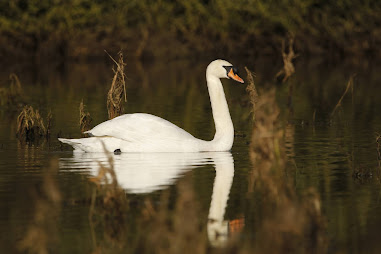I started to visit the area more intensely after a third lockdown was enforced. I decided to concentrate on an underwatched area, somewhere off the beaten track, where little birding has been done, a blank slate so to speak. Its only a short hop away from me, on the border of Ipswich, but yet manages to be people-free, lying as it does between residential areas. This is important to me as I work in a very busy and congested environment, so I really can get away from it all and unwind both physically and psychologically, for which I find birding so important. I visited the area four times in this period and hope to visit a couple of times a month for the rest of the year, unless other things get in the way.
The small reedbed, the one used in the title, used to be a Suffolk Wildlife Trust reserve, however the reserve has been taken off the website and the info sign has been taken down, so it is designated no longer. The area I visit follows the river Gipping up and down, starting behind a disused factory all the way up to a junction of the A14. The river here is broad and gently meanders. There is the small reedbed that gives the area its name, which is becoming overgrown now. The rest of the area is seasonally flooded pasture grazed by cattle in the summer. A new feature are some trees that have been planted along the entire Gipping, with over fifty in this area alone. This planting was undertaken by the Suffolk Wildlife Trust and the Environment Agency and is a nice feature of the area, as there aren't many trees around here.

Other than that, birdwise the area is fairly quiet, I don't usually see that much on each visit, but as a slice of English countryside its fairly representative. It attracts small numbers of wetland birds and those of the general countryside. Whenever I visit I see a GREY WAGTAIL by the mill, now a block of apartments, with a maximum of three 5/3. There were several singing CETTI'S WARBLERS, a bird which has pretty much colonised every corner of Suffolk. A REED BUNTING sang from the reedbeds, all common birds, but birds that have been sidelined in our countryside.
With a winter full of rain and flooding, a visit on the 29/1 saw the site completely flooded. The Gipping had burst its banks, covering the meadows entirely in flood water. The only place free was the tiny parking spot, on a slight rise over the rest of the area. On that day there was a singing MISTLE THRUSH, its haunting call ringing out over the water. A week later I heard a SONG THRUSH, its elaborate song calling out in the gentle air of the countryside. On 5/3 a large flock of 70 REDWINGS were in the tree plantation across the river, a sign of birds on the move, its been a good winter for those birds.
On one visit, 5/2, I had a tiny flock of three SISKIN in some riverside alders, not large numbers but a new species for the site, with few trees little birds are quite scarce. Whilst walking up the river I disturbed and put to flight a TEAL from the reedbeds. On the same day a sign of spring was in the air with the arrival of a pair of MUTE SWANS on the same area of flooding as the geese. These birds might be potential nesters and birds which might maybe stay the summer on the river. They were seen again on a later date, this part of the river being quieter it would be a good area for them to nest in.
A snapshot of an area of countryside, not particularly special in any way but still fairly interesting. This is an area I don't know well, so I wonder what I'll see over the course of a year, so in some ways its quite exciting (yes I know I'm quite sad). In some ways its important to monitor these areas as being on the edge of Ipswich land is a high value commodity, nature a low one where money is concerned. As a result this will be record of somewhere that may not exist in the future, a museum piece of a land that was lost for wildlife.







No comments:
Post a Comment